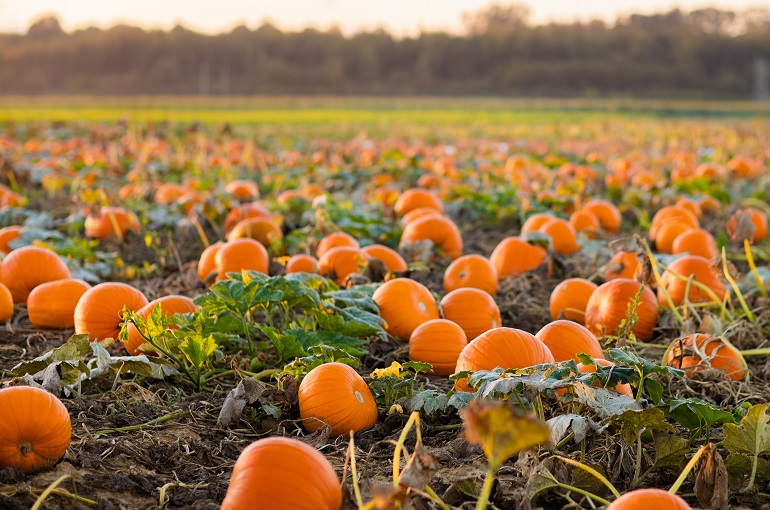Plant Information and Variety Selection of Pumpkins

This post is also available in:
This post is also available in:
![]() Español (Spanish)
Español (Spanish) ![]() हिन्दी (Hindi)
हिन्दी (Hindi) ![]() Ελληνικά (Greek)
Ελληνικά (Greek) ![]() Português (Portuguese (Brazil))
Português (Portuguese (Brazil))
Pumpkin types and variety selection
The Cucurbita genus includes numerous species (5 domesticated and 22 wild species) of pumpkins and squash (these common names are used to describe various varieties and species). Among them, the three Pumpkin-Squash species with the highest economic value and worldwide cultivation and consumption are the:
- C. pepo (depending on the subspecies, the common names are: field pumpkin, acorn squash, summer squash, winter squash, zucchini/courgette). It is native to North America (Mexico).
- C. maxima (common names: winter squash, pumpkins, buttercup squash, marrow). It is native to South America.
- C. moschata (common names: Butternut squash, grammas, winter squash, Calabaza). This species is native to Central and South America.
The identification of the different species by visual observations is quite difficult. Some believe that a reliable identification feature is the stalk of mature fruit (close to the attachment point). For example, C. maxima have a soft spongy stalk, while C. pepo and C. moschata have a hard stalk.
Some popular types-varieties of pumpkins per species are:
Of the C. maxima species: “Jarrahdale” (with grey skin and a vivid orange color flesh), Big Max, Mammoth Prize, and Atlantic Giant
Of the C. pepo species: the Jack O Lantern, Spirit, Connecticut Field, Howden’s Field, Funny Face, Small Sugar, and Jackpot.
The most important thing a pumpkin farmer should take into account before selecting a variety to grow is the good adaptation of it to the local conditions and the market goal he/she has.
- Miniature fruits, smaller than o.45 kg (1 pound) can be used for decorative purposes
- Pie Pumpinks usually weigh2.3-4.5 kg (5-10 pounds)
- Larger pumpkins of 4.5-11.3 kg (10-25 pounds) usually go for processing
- Giant fruits like the jack o’ lantern pumpkins that are over 11.3 kg, yo to 34 kg (25 pounds (up to 75 lb)) are preferred for curving (on Halloween), processing, or for competitions.
The field size (available space) should also be considered since some varieties produce enormous fruits or expand a lot needing more space and larger planting distances. Finally, there are pumpkin varieties available in the market that are more suitable for organic farming.,
Pumpkin plant physiology
Pumpkin is a warm-season, annual herbaceous, creeping vine with strong roundish stems-veins (up to 15 m or 50 ft long) and kidney-shaped to roundish, rough, and prickly leaves (7-18 x 7-25 cm or 0.2-0.6 x 0.2-0.8 ft). The plants usually grow 21-91 cm (0.7-3 ft) tall and 3.5-6 m (12-20 ft) wide. The axillary flowers are large, yellow-orange, and unisexual (monoecious with female and male flowers on the same plant). The fruit is characterized as a berry. Usually, this type of pumpkin has hard skin and flesh. The pumpkin fruit may weigh from 3 to 34 kg (7-75 lb), depending on the species. The pumpkin seeds are ovate of light yellow-beige color (18-22 x 10-12 mm or 0.7-0.9 x 0.4-0.5 in).
Climate requirements of pumpkins
Generally, pumpkins can be cultivated successfully in plant hardiness zones 3-7, where the temperature ranges between 18-35 °C (65-95 °F). More specifically, for the pumpkin seeds to germinate, the soil temperature needs to be higher than 15 °C (60 °F) and ideally between 29-32°C (85 °F-90 °F). Temperatures below 5 °C (41 °F) for several days may delay growth and damage the plants, while even an hour of frost (below 0°C, 32°F) can be fatal. Keep in mind that cool temperatures or temperatures above 35 °C (95 °F) during flowering may boost most pumpkin plants to produce more male than female flowers, resulting in reduced yield. To increase fruit set, some farmers place 1 hive (honeybees) per acre (or 1 per 2-3 acres) or 2-3 hives per hectare. Pumpkins prefer many places (6-8 hours of direct sun daily) but can withstand some shade and can grow even at 3,800 m altitude. C. maxima varieties are relatively heat and drought-tolerant.
References
- https://www.jstor.org/stable/4255033
- https://plants.ces.ncsu.edu/plants/cucurbita-maxima/
- https://www.gbif.org/species/7317523
- https://plants.ces.ncsu.edu/plants/cucurbita-pepo/
- https://plants.ces.ncsu.edu/plants/cucurbita-pepo/
- https://sfyl.ifas.ufl.edu/lawn-and-garden/florida-pumpkins/
- https://zaszambia.wordpress.com/2021/10/02/ultimate-pumpkin-cultivation-guide/
- https://www.fao.org/faostat/en/#data/QC
- http://pfaf.org/user/Plant.aspx?LatinName=Cucurbita+maxima
- https://web.extension.illinois.edu/pumpkins/varieties.cfm
- https://extension.uga.edu/publications/detail.html?number=B1180&title=commercial-production-and-management-of-pumpkins-and-gourds
- http://www.omafra.gov.on.ca/english/crops/facts/00-031.htm#climatic
- https://extension.psu.edu/pumpkin-production
Read more
15 Interesting Facts about Pumpkins
Pumpkin Nutritional Value and Health Benefits
Growing Pumpkins in Your Backyard
Plant Information and Variety Selection of Pumpkins
Soil Requirements, Soil Preparation and Planting of Pumpkin
Growing Pumpkins Outdoors for Profit – Complete Growing Guide from Start to Finish
Pumpkin Yield, Harvest and Storage
Common Pumpkin Pests, Diseases, and Weed control








































































